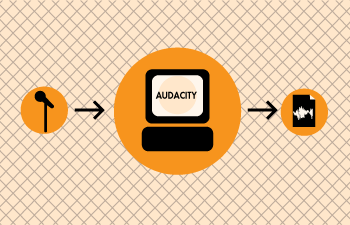Audacity
The Audacity program is an example of an 'audio editor'. Which means Audacity can record and edit audio. Typically, one uses Audacity for recording sounds, like interviews or musical instruments. You can then use Audacity to combine these sounds and edit them to make documentaries, music, podcasts, etc.
In the old days, audio editing was done with huge machines that recorded sound to tape (similar to the tape in tape cassettes).

Audio engineers would then edit these tapes using razor blades and sticky tape. Much of the jargon used in audio editing today comes from this process. Making a "cut" meant literally cutting the audio tape at a certain point. "Multitrack" referred to recording many separate sounds onto extra wide tape to fit more 'tracks'. The recording industry still uses these terms, and more, today. Many of the fundamental techniques which formed good audio recording and editing practices then, laid the foundation for recording and editing software.
While many of the terms and techniques remain the same today, computers replaced tape machines, and digital files succeeded tapes. Hence, one records audio and edits with a computer (using software like Audacity), and stores these sounds in files on a computer. This makes the process faster and requires a lot less physical storage space.

Audacity is a powerful tool for recording and editing audio on a home computer. Its is a very sophisticated program and can do everything one would expect from a modern audio editor. Audacity perhaps falls short of meeting the needs of professional recording studios, but not by much.
One can install and run Audacity on Linux, Mac OS X and Windows.





